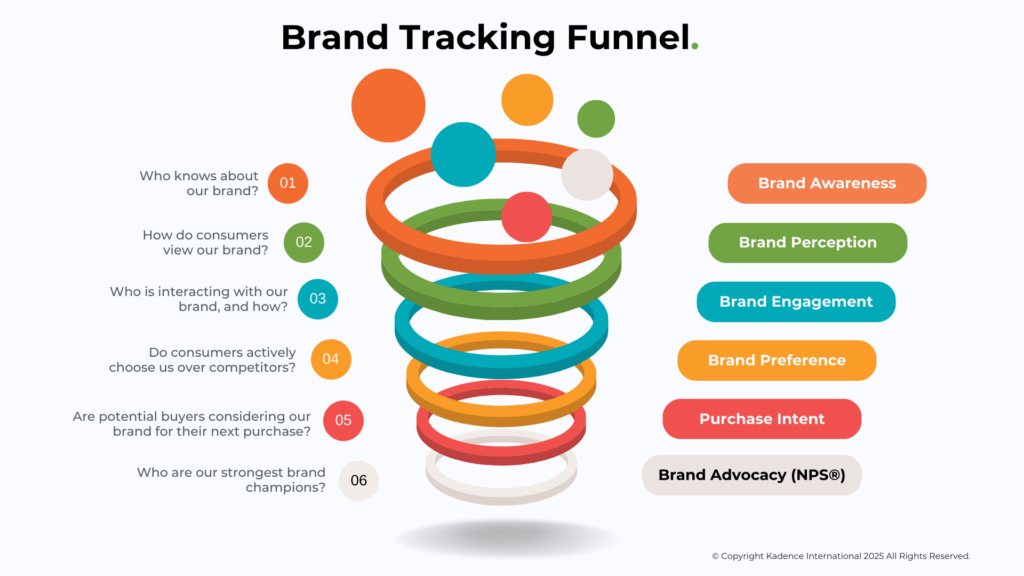Consumer sentiment shifts rapidly, shaped not only by your company’s directives and strategies but also by external forces, such as viral trends, cultural movements, and economic forces. The brands that endure and adapt to these changes in real-time. Brand tracking is more than a periodic check-in – it’s essential for survival. By continuously monitoring brand health, companies can identify strengths, spot weaknesses, understand competitive positioning and adjust strategy accordingly.
But perception isn’t static. A brand with strong awareness today can lose relevance tomorrow if it fails to track how consumers feel, engage, and respond over time. To remain competitive, brands must continuously track their position in the market and be agile enough to adapt.
What is Brand Tracking, and Why Does it Matter?
Brand tracking measures a brand’s performance over time, helping companies identify shifts in the market, consumer trends, competitive trends, strengths, weaknesses, and opportunities to refine brand strategy.
Brand perception is fluid and influenced by consumer experiences, media narratives, and competitive shifts. Brand tracking helps companies answer critical questions:
- Is our brand positioning resonating with the right audience?
- How does our reputation compare to competitors?
- What messaging, campaigns, or brand attributes build consumer loyalty?
- Do external factors – economic shifts, social trends, or market disruptions – impact our brand perception?
Key Elements of Brand Tracking
Brand tracking goes beyond surface-level metrics to assess a brand’s health and market position. Key components include:
- Brand Awareness: Measuring Recognition and Recall
- Unaided vs. Aided Awareness
- Top-of-Mind Awareness: The first brand a consumer thinks of in a category often signals market leadership and competitive strength.
- Brand Perception & Sentiment Analysis
- Consumer Attitudes and Associations: Understanding how consumers feel about a brand—and the attributes they link to it—is key to shaping brand identity. These should include both functional benefits and emotional benefits. As well as brand personality.
- Purchase Intent, Satisfaction & Customer Loyalty Metrics
- Likelihood of Purchase: Gauging how likely consumers are to choose a brand helps predict future sales.
- Satisfaction: Understanding brand satisfaction versus competitors.
- Net Promoter Score (NPS): Measuring customers’ willingness to recommend a brand indicates satisfaction and loyalty.
- Competitive Benchmarking
- Market Position Analysis: Comparing brand performance against competitors to identify strengths, weaknesses, and market opportunities.
- Share of Voice: Measuring a brand’s visibility in the market through media coverage and advertising reach.
- Media & Advertising Effectiveness
- Campaign Impact Assessment: Assessing how marketing efforts affect awareness, perception, and sales.

Turning Data into Strategy
Brand tracking only matters if insights lead to action. Using data strategically, companies can refine marketing, reposition products, and strengthen customer loyalty.
Identifying Strengths and Weaknesses Before They Become Market Issues
Tracking brand health helps brands pinpoint areas where they excel and where they are losing ground. Rather than relying on assumptions, brands that act on measurable shifts in consumer sentiment can adjust messaging and engagement tactics before losing relevance.
Optimizing Marketing Campaigns
Effective marketing isn’t just about visibility; it’s about impact. Brand tracking measures how marketing efforts influence perception, loyalty, and purchase intent. If a campaign falls short, data allows brands to tweak real-time messaging rather than wait until the next cycle.
Benchmarking Against Competitors
Brand tracking is most powerful when measured against competitors. Comparing brand health metrics against competitors enables companies to identify gaps in positioning, capitalize on underserved markets, and anticipate industry shifts before rivals do.
Building Customer Loyalty
Brand tracking isn’t just for attracting new customers; it helps brands understand why existing customers stay or leave. Tracking loyalty metrics allows brands to implement better retention strategies, such as loyalty programs, improved customer service, or product innovation.
Brand Tracking Mistakes and How to Avoid Them
Even the best tracking methods fail if poorly executed. Avoid these common mistakes to ensure insights lead to action.
- Measuring Awareness Without Sentiment
A high awareness score means little if there are negative perceptions. Brands must pair awareness tracking with perception analysis to get a complete picture of their market position. - Tracking Without Business Goals
Brand tracking is useless if not tied to clear objectives. Tracking must support strategy, whether expanding markets, improving retention, or refining advertising. - Ignoring Qualitative Data
Numbers alone don’t tell the full story. Open-ended customer feedback and sentiment analysis reveal why brand perception shifts. - Failing to Act on Insights
Insights are useless if brands don’t act. Whether trust is eroding or a competitor is gaining ground, companies must adjust accordingly. - Overlooking Market Trends
Brand perception doesn’t exist in a vacuum. Economic shifts, cultural trends, and competitors shape public opinion. Effective tracking accounts for these factors.
Brand Tracking Is Not an Option—It’s Survival
Brand perception is a moving target. What consumers think today may not hold true tomorrow, and brands that fail to monitor these shifts risk becoming irrelevant. The market does not wait for companies to catch up; brands that do not track, analyze, and act on data are at the mercy of competitors who do.
Tracking isn’t just about data—it’s about influence. It reveals when a brand resonates or repels, when trust strengthens or erodes. The best brands spot risks before they escalate and seize opportunities before they go mainstream.
Market leaders don’t wait for a crisis to understand their position. They track, measure, and adapt before perception shifts beyond their control. A brand that isn’t tracking its relevance isn’t just falling behind – it’s already lost control of the narrative.
Get regular insights
Keep up to date with the latest insights from our research as well as all our company news in our free monthly newsletter.





 Senior Marketing Executive
Senior Marketing Executive Sales & Marketing
Sales & Marketing General Manager PR -Internal Communications & Government Affairs
General Manager PR -Internal Communications & Government Affairs Vital Strategies
Vital Strategies
 Customer Intelligence Director
Customer Intelligence Director